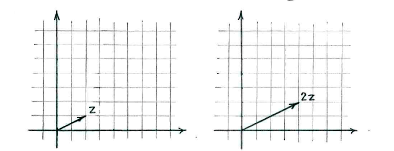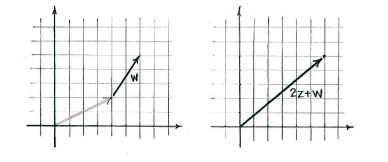Lösung 3.2:1c
Aus Online Mathematik Brückenkurs 2
(Unterschied zwischen Versionen)
K |
|||
| Zeile 1: | Zeile 1: | ||
| - | {{NAVCONTENT_START}} | ||
By calculation, we obtain | By calculation, we obtain | ||
| - | <math> | + | {{Displayed math||<math>2z+w = 2(2+i)+(2+3i) = 2\cdot 2 + 2 + (2+3)i = 6+5i</math>}} |
| - | + | ||
and we can mark this point on the complex plane. | and we can mark this point on the complex plane. | ||
| - | If we treat <math>z</math> and <math>w</math> as vectors, then | + | If we treat <math>z</math> and <math>w</math> as vectors, then <math>2z</math> is the vector which has the same direction as <math>z</math>, but is twice as long. |
[[Image:3_2_1_c1.gif|center]] | [[Image:3_2_1_c1.gif|center]] | ||
| Zeile 14: | Zeile 12: | ||
[[Image:3_2_1_c2.gif|center]] | [[Image:3_2_1_c2.gif|center]] | ||
| - | {{NAVCONTENT_STOP}} | ||
Version vom 09:23, 29. Okt. 2008
By calculation, we obtain
| \displaystyle 2z+w = 2(2+i)+(2+3i) = 2\cdot 2 + 2 + (2+3)i = 6+5i |
and we can mark this point on the complex plane.
If we treat \displaystyle z and \displaystyle w as vectors, then \displaystyle 2z is the vector which has the same direction as \displaystyle z, but is twice as long.
We add \displaystyle w to this vector and get \displaystyle 2z+w.


